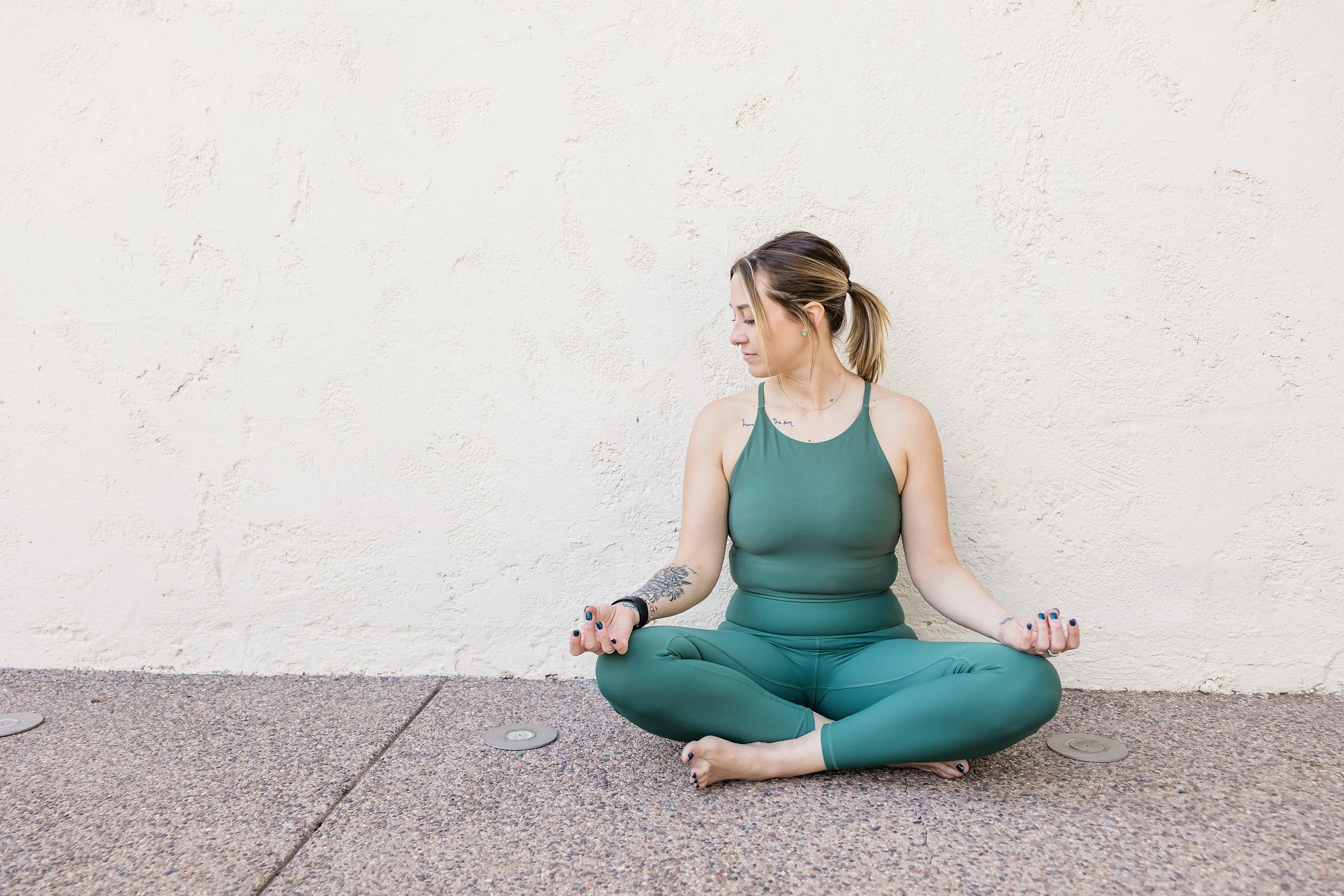How to Ease On-the-Spot: A Clear and Simple Guide to RAIN Meditation
Sometimes when you’re in the throws of anxiety, it can add more anxiety when you have to try to decide, “uhhh how do I wanna handle this?”
That’s where RAIN comes in. RAIN is a 4 step, easy to use process that helps you work with difficult feelings. It’s my go-to tool when anxiety hits, because it’s so dang easy to use and it really helps.
What you’ll get:
The benefits of RAIN
What each step of RAIN entails.
How to incorporate RAIN into your meditation practice.
How RAIN can help you when you’re in the anxiety storm.
Let’s get started!
The Benefits of Practicing R.A.I.N.
1.) Emotional Regulation
RAIN meditation helps regulate difficult emotions by recognizing and accepting them, allowing you to respond skillfully instead of reacting automatically. It creates space for a more balanced and compassionate response.
2.) Increased Self-Awareness
RAIN cultivates self-awareness by encouraging you to recognize and investigate your thoughts, feelings, and bodily sensations. This heightened awareness helps you understand yourself better and make conscious choices.
3.) Stress Reduction
By accepting and investigating your experiences without judgment, RAIN meditation reduces stress and anxiety. It helps you learn to drop the struggle with anxiety, allowing you to navigate challenging situations with greater ease.
4.) Emotional Healing
RAIN provides a compassionate and non-judgmental approach to healing emotional wounds. By nurturing yourself through the process, you can gradually release and heal unresolved emotions, fostering emotional well-being.
5.) Mindfulness Development
RAIN is a mindfulness practice that deepens your ability to stay present and observe experiences without getting entangled in them. It strengthens your mindfulness muscle, enabling you to be more fully present in each moment.
6.) Self-Compassion and Self-Acceptance
The nurturing aspect of RAIN promotes self-compassion and self-acceptance. By recognizing and accepting your experiences, even the challenging ones, you develop a kinder and more understanding relationship with yourself.
7.) Clarity and Insight
RAIN meditation encourages investigation, leading to greater clarity and insight into your patterns of thinking, feeling, and behaving. This clarity enables you to make wiser choices and develop a deeper understanding of yourself and others.
8.) Improved Resilience
By practicing RAIN meditation, you develop emotional resilience and adaptability. It helps you navigate difficult emotions and experiences, fostering inner strength and the ability to bounce back from adversity.
The 4 Steps of R.A.I.N.
1.) Recognize
Recognize What’s Happening.
The first step to rain is to simply recognize, or name, exactly what’s happening. We’re starting to drop our attention inward. Name whatever thought patterns, feelings, or sensations most stand out to you. Is there anger? Jealousy? Sadness? Check out the nature of your thoughts, is there busyness? Planning mind? Maybe your mind is caught up in worry. Label whatever it is, with an attitude of non-judgment.
Begin by Recognizing: Drop your attention inward.
Identify Your Feelings: Whether it's anger, jealousy, sadness, etc.
Note Thought Patterns: Busyness, planning, worrying, or other prevalent thoughts.
Label with Clarity: Clearly name what you observe.
Maintain Non-Judgment: Approach this recognition with a neutral, accepting attitude.
2.) Allow
Allow Life to Be As It Is.
In the allow step, the goal is to practice letting whatever is present to be as it is. Sometimes it can be helpful to say “yes” to whatever you’ve recognized , or to play around with other phrases like, “I consent”, “this too is present”. Anything that helps you cultivate acceptance of whatever is arising will work.
Embrace the Present: Accept whatever feelings or thoughts you've recognized.
Avoid Suppressing: Don't push away or ignore what you've identified.
Give Permission: Let feelings or thoughts be there without trying to change them.
Stay Neutral: View emotions and thoughts as passing events, not defining truths.
3.) Investigate
Investigate Your Inner Experience Non-Judgmentally.
In the "Investigate" step of RAIN, focus primarily on bodily sensations rather than over-analyzing. Scan your body: perhaps there's tension in your neck? Additionally, reflect briefly on any self-beliefs in the moment, like feeling "not good enough." Approach all findings with a non-judgmental attitude.
Tune Into the Body: Direct attention to any physical sensations that arise with certain emotions or thoughts.
Stay Curious: Delve into your feelings without judgment, maintaining an open-minded attitude.
Uncover Underlying Beliefs: Gently probe for any deep-seated, fear-based beliefs that might be influencing your reactions. (For example, if you feel anxious about social situations, the underlying belief might be "I'm not interesting enough" or "People will judge me.")
Avoid Over-Analyzing: Approach the investigation with a sense of curiosity rather than trying to "solve" or "fix" your feelings, which can deepen anxiety.
4.) Nurture
Nurture The Hurting Place.
The nurture step is an opportunity to practice tending towards your challenging thoughts and feelings with kindness. So maybe ask the part of you that is struggling; “what do you need right now?” Maybe it needs to be held with acceptance, maybe it needs some space or some specific kind, healing words.
Offer Self-Compassion: Treat yourself with the same kindness you'd show a friend.
Positive Self-Talk: Remind yourself of your worth and strength.
Visualize Comfort: Imagine a comforting presence, whether it's yourself or someone else, offering solace.
Reassurance: Remind yourself that emotions are temporary and that you have the tools to navigate them.
Physical Touch: Oftentimes it can be helpful to just place your hand on your heart, or wherever you’re feeling tension, and breath into the space in your body where the pain is presenting itself.
RAIN Interactive Tool
Welcome to the RAIN Mindfulness Tool
This tool guides you through the four steps of RAIN, a practice for mindful acceptance of your emotions and thoughts.
Recognize
What are you feeling right now? Take a moment to recognize the emotion or thought without judgment.
Allow
Can you let this emotion or thought exist? Allow it to be there without trying to change it or push it away.
Investigate
Now, gently investigate your inner experience. What core beliefs are associated with this emotion or thought?
What physical sensations are you feeling in your body?
Nurture
Offer yourself phrases, gestures, or visualizations of compassion. What do you need to hear or feel right now?
Some Quick Background
R.A.I.N. was first introduced by meditation instructor Michele McDonald, and has been popularized by psychologist & meditation teacher, Tara Brach. RAIN is an acronym for a four step process of working with difficult feelings. It stands for recognize, allow, investigate, and nurture.
When RAIN Might Help you
When tricky feelings come up and you’re feeling stuck.
When the feelings are getting in the way of you being present with what matters.
When you need a tool to handle anxiety.
Using RAIN in Your Meditation Practice
This practice can be used either formally as a seated meditation, or informally on the spot as stuff comes up throughout the day.
The formal meditation time allows us to sit quietly and strengthen skills of mindful awareness while we’re not in the thick of things.
When we include the formal sitting practice in our routines, it helps us train the mindfulness muscles in our brains, making it easier to tap into R.A.I.N. throughout the day.
How to Practice R.A.I.N. On the spot
This can be as simple as taking a few moments to run through the steps as difficulty comes up.
You can either run through each step, or just practice running through the first two steps (recognize and allow) when you just have a quick moment.
Being able to intentionally practice on the spot with smaller difficulties to start, helps us feel more confident in dealing with challenges as we move forward.
After the R.A.I.N.
When you’re done with the steps of RAIN, check in and notice what your experience is like now vs when you started the exercise. This is another opportunity to accept your experience just as it is. Again, feel free to practice this formally, sitting in a quiet, comfortable space, or try running through the steps throughout the day.
Either way, I hope with practice this can help you move towards feeling more confident when you come across difficulties and discomfort in your life!
Hi, I'm Ellie! I offer online therapy for women and couples in Maryland and Virginia, focusing on anxiety management and relationship strengthening.
Hop over to my website for a helpful anxiety relief freebie. If you're local, let's see if we're a good therapy match!











